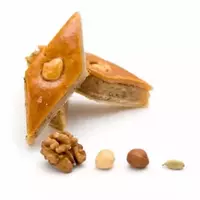Baklava

Oriental sweetness and popular baklava confectionery are well known to most residents of the post-Soviet space. The second name for Baklav sweetness comes from Turkish. Pahlava is considered its national dish by countries such as Uzbekistan, Iran, Turkey, Azerbaijan and Turkmenistan. In Bulgaria and Greece, baklava sweetness is also prepared from puff dough, to which nuts, sugar syrup, honey or molasses are added.
The recipe for Assyrian baklava was found by researchers in a cookbook that is stored in the Ottoman Museum (Toakana Palace) and dated to the 15th century. Uniquely, the cookbook lists the month and year (August 145
3) of production of the first baklava for Sultan Fatih. According to another version, back in the VIII century BC, baklava or baklava was invented in modern Turkish territory, from where Greek traders brought sweetness to their homeland.
Since then, the Athenian or Greek version of baklava has been popular in Greece. The ancient Greeks made some changes to the original recipe for baklava dough, which is successfully used in modern times to make sweets. Baklava refers to special confectionery products and not only because of the composition of the initial ingredients. The process of producing sweets is unique, in which baklava dough is rolled out to a very thin sheet. Moreover, the manufacture of baklava requires special skill and an unusually long rolling pin.
In Turkey, dough is rolled out with two-meter wood rolling pins here. Turkish pastry chefs skillfully wind the thinnest dough on a rolling pin, and then throw it off and repeat the process several times. At this time, nuts (pistachios, almonds and walnuts) are cooked in honey, rose water-based sugar syrup or molasses. Spices and spices are necessarily added to real eastern baklava. The result is oriental sweetness in the form of the thinnest sheets of dough, with finely chopped nuts between layers, which are soaked in spiced sugar syrup and lemon juice.
Pistachios are most often used for baklava in Turkey, but nothing prevents you from using nuts to your taste for making sweets. The calorie content of baklava is at a fairly high level, this is primarily due to the composition of the product. The average calorie level of baklava, which was prepared according to the classic recipe for honey, is 406 Kcal per 100 grams of sweetness. However, for that, baklava and oriental sweetness, which have long been appreciated not only for excellent taste, but also for the nutrition, as well as the benefits that human health brings. Baklava will be an excellent and non-standard dessert for special occasions.
baklava 406.17 kKal
Energy value of baklava (Ratio of proteins, fats, carbohydrates - ju):
Proteins: 6.2 g (~ 25 kCal)
Fats: 15.45 g. (~ 139 kCal)
Carbohydrates: 60.97 g (~ 244 kCal)
Energy ratio (bj | y): 6% | 34% | 60%
 Español
Español Français
Français Português
Português Русский
Русский 简体中文
简体中文 繁體中文
繁體中文 日本語
日本語 한국어
한국어 العربية
العربية Türkçe
Türkçe Қазақ
Қазақ Deutsch
Deutsch Italiano
Italiano Українська
Українська
